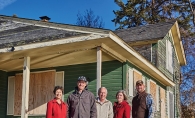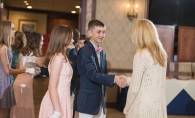While living in the Democratic Republic of the Congo, Marie Claire Pambani made her living with the help of a needle and thread. After emigrating in 2002, Pambani, a former seamstress, had to fit her new life through an eye of a needle, trying to understand this country’s cultural, economic and educational patterns.
With the help of Neighborhood House’s English Language Learner (ELL) program, Pambani has made huge leaps. Where once she didn’t know basic math functions, she is now proficient in algebra. She rarely misses her math classes, explaining her teachers take plenty of time to explain the lessons. “You can understand easily,” Pambani says.
The mission of Neighborhood House is to offer participants the “tools needed to move from survive to thrive.” This encompasses several elements, including two multi-cultural food markets, offering more than 2,500 pounds of food daily to about 12,000 families a year and programs for youth, adult and family education. Neighborhood House serves immigrants, refugees or long-term residents who are facing challenges. More than 90 percent of the 15,000 people served annually live at or below the poverty level. In terms of participation in the adult education program, 60 percent are Hispanic, 20 percent East African, 10 percent Asian and the rest falling into “other.” Approximately 75 percent speak a language other than English in their homes.
Neighborhood House has approximately 60 full-time staff and about 3,000 volunteers. The Adult Education Department has eight staff members and 45 to 50 volunteers, according to adult education program supervisor Allie Bezat Riley.
As part of Neighborhood House’s adult education program, ELL classes assist adult students in mastering skills necessary to live and work in this country. Programs include English classes, which incorporate the language into computer skills, financial literacy and understanding the education, health care and legal systems of the United States. Civics courses for intermediate and advanced ELL students embed language and employment skills into various areas, including American history, education, community resources and workers’ rights. All English classes include elements to explore everyday situations, including shopping, transportation and housing.
Classes are taught by staff and volunteers. “We always need volunteers,” Riley says. “All of our volunteers are highly skilled.” If volunteers who want to teach don’t have previous classroom experience, they receive training through the Minnesota Literacy Council (MLC). The training guidelines can require Riley to “dig deeper into our volunteer pools,” but she understands the need to ensure qualified volunteers serve in the classrooms. Education volunteers are asked to commit at least three hours a week for 10 to 12 weeks. “The students need consistency with their teachers,” Riley says.
Riley began her relationship with the ELL program as a volunteer English teacher in 2009. “My interest grew,” she says, expanding her volunteer efforts because she “enjoyed working with individuals who are motivated and want to be here.” After teaching English for a year in France, Riley returned to Neighborhood House, where she’s been on staff for three years. By understanding how the students navigated their countries of origin’s cultural, economic and educational systems, Riley is better able to understand their perspectives. “They have so much to teach us, too,” she says.
ELL volunteer Jan Anderson agrees. “I think the students’ stories are so inspiring,” she says. Anderson respects their commitment to learning even as they work and tend to their families, often coming to class before or after long hours at work. “They want to make it, and they are determined to make it,” she says.
Anderson, a former German and Spanish teacher, has volunteered as an English language teacher for 13 years. “It’s so rewarding,” she says. “There are so many opportunities to give back, and this is a great one.”









